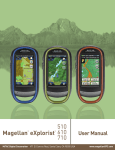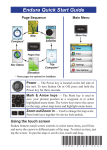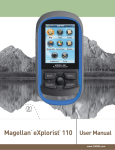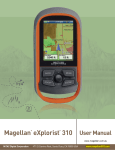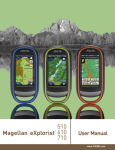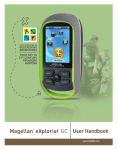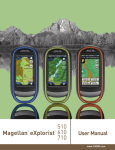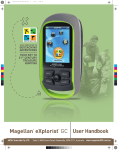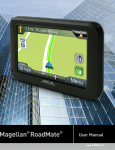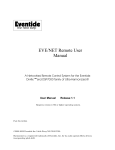Download Magellan® eXplorist 310 North America 2.2" Screen
Transcript
Magellan eXplorist 310 ® ® User Manual www.CARiD.com Using the Magellan eXplorist The Magellan eXplorist GPS receiver is designed to be easy enough for the casual ‘explorer’ as well as having all of the advance features the ‘enthusiast’ requires. This chapter provides information on the basics of using the Magellan eXplorist GPS receiver. Use of the Joystick to Select or ENTER. Throughout this manual you will be asked to ‘select’ a button or icon. This is done by using the joystck (left, right, up, down) to highlight the item on the display. Pressing down on the joystick provides the ENTER command to the receiver. Installing the Batteries The Magellan eXplorist GPS receiver uses two AA batteries that provides 16 hours of normal use. (See the section on Power Settings for details as to how to extend the battery life.) Lithium, alkaline or rechargeable batteries can be used but both batteries need to be of the same type and should be defined in the Tools > Power function in the receiver (see Setting Battery Type). Replacing the Batteries 1. Remove the battery door by raising the arm on the battery door lock and turning it counter clockwise for one-quarter of a turn. 2. Remove the battery door. The battery door pivots from the bottom. The pivot points will release when the top of the battery door is being raised. 4. Replace the battery door by first aligning the pivot tabs at the bottom of the door with the receiver. 5. Lower the battery door until it seats firmly against the receiver. (Note: you may need to turn the battery door lock counter clockwise to allow the door to seat against the back of the receiver.) 6. Turn the battery door lock clockwise, locking the door in place. Setting the Battery Type 1. With the receiver on and the Map screen displayed, press the BACK button. 2. The Menu screen is displayed. Use the joystick to highlight the Tools icon. Press the joystick to Enter. 3. Select Settings (use the joystick to highlight Settings and press the joystick for Enter.) 3. Install two AA batteries as shown. 4. Select Power. 5. Select Battery Type. A drop-down menu is displayed. 6. Select the type of battery installed; Alkaline, Rechargeables or Lithium. 7. Use BACK button to return to the Menu screen. Magellan eXplorist 310 User Manual Using the Magellan eXplorist 8. Select the Map icon to return to the Map screen. Powering the Magellan eXplorist Turning the Receiver On Setting Active Suspend Timer This option sets the time duration that if the display is not touched that the receiver will automatically go into Suspend Mode. Press the Power button to exit Suspend Mode. 1. With the receiver on and the Map screen The power button is recessed and requires that you hold it down for 2 seconds to prevent accidental power on. 1. Press and hold the Power button (top left of the receiver) for 2 seconds. displayed, press the BACK button. 2. Select the Tools icon at the bottom of the display. 3. Select Settings. 4. Select Power. Turning Receiver Off When turning the receiver off you have two options, Suspend, Sleep or Power OFF. Suspend: Turns off the receiver display but the GPS information will continue updating. Also if you have an alarm set, it will continue to alert you at the appropriate times. Use the Power button to active the display while suspended. Sleep: (Option is displayed only when an alarm is set.) Turns off the display and the GPS receiver but alarms will continue to function, providing alerts for the current alarm settings. Use the Power button to active the display and GPS while asleep. Power OFF. Shuts the receiver off completely. 5. Select Active Suspend Timer. A drop-down menu is displayed. 6. Select the duration that the receiver will automatically go into suspend mode when the display is not touched. Setting Power OFF Timer This option sets the time duration that the receiver will power off if the display is not touched. (Useful for times when you forget that you set the receiver in suspend or sleep mode.) 1. With the receiver on and the Map screen displayed, press the BACK button. 2. Select the Tools icon at the bottom of the display. 1. Press the Power button. 3. Select Settings. 2. Select Suspend, Sleep (when available), or 4. Select Power. Power OFF. 5. Select Power OFF Timer. A drop-down menu is displayed. Warning: Use caution when setting the receiver in Suspend or Sleep mode. The receiver will appear off but is still using battery power. Be sure to turn the receiver off using Power OFF whenever not in use. Conserving Power The Magellan eXplorist can be customized to extend the battery life of the AA batteries installed. There are four functions, (Backlight Timer, Brightness, Active Suspend Mode, and Power OFF Timer) that can be set to help extend battery life. 6. Select the duration that the receiver will automatically power off when the display is not touched. Setting Backlight Brightness The receiver backlight is one of the primary drains on the battery life. Setting the brightness to about 40% and the backlight timer to 1 minute provides a good user experience as well as extends the battery life. 1. With the receiver on and the Map screen displayed, press the BACK button. 2. Select the Tools icon at the bottom of the display. 3. Select Settings. Using the Magellan eXplorist 4. Select Brightness & Volume. 5. Select the Brightness slider to set the desired backlight brightness. Setting Backlight Timer This option sets the time duration that the backlight will turn off if the displayed is not touched. Touch the display to restore the backlight. Main Menu The Main Menu provides access to the Map screen, waypoint tools, track tools, geocaches, route tools, address book, POI and media tools. The Main Menu is also provides access to the eXplorist tools and settings. 1. With the receiver on and the Map screen displayed, press the BACK button. 2. Select the Tools icon at the bottom of the display. 3. Select Settings. 4. Select Brightness & Volume. 5. Select the Backlight Timer. A drop-down menu is displayed. 6. Select the duration that the backlight will turn off when the display is not touched. Dashboard The Dashboard is an optional navigation screen that can be used in conjunction with the Map screen. There are eight different dashboard styles that can be selected. (See the chapter on the Dashboard screen for additional information.) Accessing the Dashboard 1. With the receiver on and the Map screen displayed, press the BACK button. 2. Select the Dashboard icon. Note: The icon displayed changes to reflect the type of dashboard being used. Accessing the Main Menu 1. With the receiver on and the Map screen displayed, press the BACK button. Options Menu The Options Menu can be found on many screens in the lower right corner of the display. This menu provides quick access to the most commonly used functions associated with the screen being displayed. Using the Magellan eXplorist The BACK Button The BACK button is used to access the previously viewed screen unless you are viewing the Map screen and then it is used to access the Main Menu. Entering Text and Numeric Data Entering text and numbers is done by the use of a displayed keyboard. Accessing the different keyboard layouts is done by Selecting on the left or right arrows. Uppercase characters can also be used by Selecting the shift key. Entering a space is done using the space bar key. To backspace, Select the backspace key. To save the text entered, Select the green accept button. To cancel and return to the previous screen Select the back button. Map Screen The Map screen will be the screen you most commonly use and a good understanding of its workings will enhance your experience with the Magellan eXplorist. The Map screen can be displayed in two modes, Navigate and Pan. In Navigate Mode your current location is displayed along with a graphical indication of where you’ve travelled (track) and information about where you are going (route). In Pan Mode you can ‘pan’ around the map looking for places to go or places to create a waypoint. Battery Life Backlight Time Mode Satellite Status Current Location Icon Map Scale North Indicator Data Fields Map Screen Overview 3. Use the joystick to set the number of data fields. 4. Press BACK to finish. Changing Zoom Levels 1. Use the Zoom + or the Zoom - buttons to change the zoom level. 2. The map scale will change and can be identified by the map scale in the lower right portion of the map. NOTE: If you are in a route the map scale can change automatically to a scale that best displays the route. You can turn autoscale off in Tools > Settings > Map Options. Setting the Number of Data Fields 1. Press MENU button while viewing the Map Customizing the Data Fields 1. Press MENU button while viewing the Map screen. 2. Select Edit Nav Fields. 3. Select the Data Field to be customized. 4. Select on the data type field from the list displayed. 5. Use the BACK button to exit. Displaying a Compass on the Map Screen 1. Press MENU button while viewing the Map screen. screen. 2. Select Edit # of Fields.... 2. Select Show Compass. Magellan eXplorist Map Screen Navigation Lines Viewing Track Summary Navigation lines are displayed on the map providing you with route destination indicators and active track. Active Track. Displays a history of your travels when you are routing to a destination. Active Track. Displays a history of your travels when you are not routing to a destination. Origin Destination Line. Originally computed route from point of origin to your destination. Route Line. Computed multi-leg route. Point Destination Line. Guidance from your current position to the destination. Hiding/Showing Active Track 1. Press the BACK button while viewing the Map screen. 2. Select on the Tracks icon. 3. Press the MENU button. 4. Select Hide Active Track or Show Active 1. Press the MENU button while viewing the Map screen. 2. Select Track Summary. 3. A summary of the current track is displayed. Viewing an Overview of the Active Track 1. Press the MENU button while viewing the Map screen. 2. Select Active Track Area. 3. The Map screen is scaled to display the entire area covered by the active track. The top of the display provides information about the area and the perimeter that the track covers. Backtrack You can use the track of your current travels to navigate back to your point of departure by creating a Backtrack route. This will provide you with the information needed to travel back to where you started following the same path used to get where you are. Creating a Backtrack Route 1. Press the MENU button while viewing the Map Track. screen. Clearing Active Track 1. Press the BACK button while viewing the Map screen. 2. Select on the Tracks icon. 3. Press the MENU button. 4. Select Clear Active Track. Starting a New Track 1. Press the BACK button while viewing the Map screen. 2. Select Start. (If a track is already being saved, you will need to select the Save icon first.) 3. Confirm that you want to delete the current active track and start a new track. This track can be paused/restarted and saved to the receiver. 2. Select Backtrack. Magellan eXplorist Map Screen Pan Mode Maps Accessing Pan Mode 1. Use the joystick to move the cursor while viewing the Map screen. 2. The Map screen goes into pan mode. 3. Keep using the joystick to display a point that you would like to create a route to or a make a waypoint. Using the Zoom In and Zoom Out buttons will help you pick the location quickly and accurately. Creating a Waypoint in Pan Mode 1. Select on the map the point at which you want to create a waypoint. 2. Press MENU. Additional maps for the eXplorist may be available from the Magellan Store at www.magellangps.com. Once the map has been purchased and installed you will need activate it in your receiver. Accessing Loaded Maps 1. Press MENU while viewing the Map screen. 2. Select Maps. 3. Choose World Maps or Detailed Maps to see the individual maps installed. 4. If the map has a checkmark before its name it has been activated and is in use by your receiver. You can toggle the map on or off by Selecting on the check mark box to the left of the map name. 5. Select the map name to get more detailed 3. Modify and save the waypoint as described in the chapter on Waypoints. information about the map that is installed. Dashboard Screens The Dashboard provides a secondary screen that can be used to assist you in your travels. There are nine screens, most of them customizable, that you can select from. Accessing the Dashboard Road Screen Displaying the Dashboard Screen 1. While viewing the Map screen, press BACK. 2. Select the Dashboard icon. 3. The currently chosen Dashboard screen is displayed. Changing the Dashboard Screen 1. Access the Dashboard screen. 2. Press MENU. 3. Select Switch Dashboard. 4. Select the icon of the Dashboard screen you want to display. Types of Dashboard Screens The Road screen displays a graphical road with a strip compass above the road. This compass displays your heading and your heading’s relation to the sun, moon and your destination (black arrow) when they are within 50 degrees on either side of your heading. The data fields at the top of the display are customizable (see Customizing the Data Fields). Compass Screen Strip Compass Screen The Compass screen displays a recognizable compass that can be used to display your heading and your heading’s relation to the sun, moon and your destination (black arrow). The data fields at the top of the display are customizable (see Customizing the Data Fields). The graphic displayed that is used for the compass is customizable as well. The Strip Compass screen displays a strip compass (similar to the Road screen but the Strip Compass screen provides more room for additional data fields). This compass displays your heading and your heading’s relation to the sun, moon and your destination (black arrow) when they are within 50 degrees on either side of your heading. The orange arrows under the strip compass will show which way to turn to head towards your destination. The data fields at the top of the display are customizable (see Customizing the Data Fields). Magellan eXplorist Dashboard Satellite Status Screen Dashboard Screen The Satellite Status screen displays a graphical representation of the satellites overhead in relation to you current location (the center of the circle) The color of the satellite graphics, as well as the bar graph, indicate the signal strength of the signals being received. The numbers indicate the assigned satellite designation. The data fields at the bottom of the display are customizable (see Customizing the Data Fields). The Dashboard Screen displays a small compass and up to eight customizable data fields. The data fields displayed are customizable (see Customizing the Data Fields). Data Only Screen Altimeter Screen The Data Only Screen displays the most number of data fields available to be viewed at one time in the receiver. Up to 12 customizable data fields can be viewed at one time. The data fields displayed are customizable (see Customizing the Data Fields). The Altimeter Screen displays detailed elevation information using the GPS signal. The area on the graph can be expanded by Selecting the icon in the lower right corner and defining the area to be used. Also a line can be moved along the graph to pinpoint an exact point on the graph and display detailed information on that point. Magellan eXplorist Dashboard Customizing Data Fields Setting the Number of Fields Displayed 1. Access the Dashboard screen you want to change the number of displayed fields. 2. Press MENU. 3. Select Edit # of Fields. (Not available on the Satellite Status screen.) 4. The current number of fields being displayed is shown with an arrow above and below it. 5. Use the joystick up or down to change the number of fields to be displayed. (Note: it stops increasing when it gets to the maximum number of fields available for the viewed dashboard screen. The number of displayed fields can be set to 0 except for the Data Only screen which has a minimum of 1.) Changing Displayed Data 1. Access the Dashboard screen you want to change the data displayed. 2. Press MENU. 3. Select Edit Nav Fields. (Not available on the Satellite Status screen.) 4. Select the type of data to be displayed from the displayed list. 5. The Dashboard screen is displayed with the data selected displayed. Waypoints Waypoints are fixed locations with a specified longitude and latitude that can be saved to your receiver. Waypoints can mark a destination, a point along the way to a destination, or a point of reference. In the eXplorist receiver you can edit saved waypoints with unique names and descriptive icons to help you identify the waypoint from a list or on the map. The Waypoint List 5. Use the keyboard to enter the first few characters of the waypoint name being searched. Accessing the Waypoint List 1. From the Map screen press BACK. 6. Select the green checkmark. 2. Select the Waypoints icon. All the waypoints 7. The Waypoint List is displayed with the results you have saved will be displayed as a list. of the search. Editing a Saved Waypoint 1. Access the Waypoint list. 2. Select the name of the waypoint to be edited. 3. The Waypoint Description page is displayed. Sorting the Waypoint List 1. Access the Waypoint list. 2. Press MENU. 3. Select Sort & Search. 4. Select sort by Nearest, Date Created, Type or Name. Icon: Select the waypoint icon to select a new icon. Use the Show drop-down menu to select All or just show Favorites. Name: Select the waypoint name and enter a new name using the keyboard. 5. Select the Back button to return to the list of waypoints. Searching for a Saved Waypoint 1. Access the Waypoint list. Description: Select the Description button. Select the screen below the Description button. Use the keyboard to enter a description for the waypoint. Select the Back icon when done. Location: Select the Location button. Select the Primary or Secondary coordinates fields. Select the coordinated to be changed and use the keyboard to enter the new values. 2. Press MENU. 3. Select Sort & Search. 4. Select the Search by Name button. Magellan eXplorist Waypoints Go to a Waypoint from the Waypoint Description 1. Access the Waypoint list. 7. Edit the waypoint as needed. 8. Select the Disk icon. 9. Select Save as Waypoint. 2. Select the name of the waypoint to be routed to. 10.Confirm the save. Saving Your Current Location as a Waypoint 3. Press MENU. 1. While viewing the Map screen press MENU. 4. Select GO. Viewing the Waypoint on the Map 2. Select Add Waypoint. 1. Access the Waypoint list. 3. Edit the waypoint as desired. 2. Select the name of the waypoint to be viewed. 4. Select the Disk icon at the bottom of the 3. The Waypoint Description page is displayed. 4. Press MENU. display. 5. The waypoint is saved and you are returned to the Map screen. 5. Select View on map. Marking a Waypoint as a Favorite 1. Access the Waypoint list. 2. Select the name of the waypoint to be added Waypoint Projection A waypoint can also be created by entering the distance and heading for the waypoint from your current location. to your Favorites list. Projecting a Waypoint 3. Press MENU. 1. Select the Map screen. 4. Select Favorite. 5. The Waypoint Description page is displayed with a yellow star added to the icon in the upper left corner indicating that this waypoint is part of your favorites. Waypoints and the Map Screen Waypoints can be viewed on the Map screen using the default icon or the icon you select while editing the waypoint. Creating a Waypoint while Panning 2. Select the Main Menu icon in the lower left corner. 3. Select the Waypoints icon. 4. From the Waypoint List press the MENU button. 5. Select Add Waypoint. 6. Select Projection. 7. Select the Bearing field. Use the keypad to enter the degrees that the projected waypoint is from your current position. 1. Select the Map screen. 8. Select OK. 2. Use the joystick to move the cursor. 9. Select the Distance field. (Note that you can 3. This will put the Map into Pan mode. Keep using the joystick in the direction of the map you want to go to. Using the zoom buttons will assist in getting to the desired point quickly and accurately. 4. When you can see the point on the map you want to create a waypoint for, press the MENU button. Select the units of measure drop-down menu to change the units to be used. 10.Use the keypad to enter the distance from your current location that you want to project a waypoint. 11.Select OK. 12.Select Next>. 13.The Waypoint Description page is displayed. 5. Select Add Waypoint. 6. The Waypoint Description page is displayed. Make the necessary edits and Select the Disk icon at the bottom to save. Geocaches Geocaching is an outdoor activity that uses your receiver to find hidden treasures (geocaches) that can be placed anywhere in the world. A typical cache is a small, waterproof container containing a logbook and “treasure”. The Magellan eXplorist receiver is designed to connect with millions of passionate adventure seekers at www. geocaching.com. Geocaching.com is the premier website for organizing the world’s geocaches. Whether you want to learn about geocaching, hide or seek a cache, log your experiences, or find out about a local geocaching event, Geocaching.com is your one-stop shop for all things geocaching! No need to worry about clumsy data conversion as the eXplorist receiver connects seamlessly with the website for popular features such as Send to GPS, Upload Field Notes, and transfer Pocket Queries. Installing Geocaches (Send to GPS) Installing Geocaches with ‘Send to GPS’ (List Page) 1. Go to site on your browser. 2. Use the search tools on geocaching.com to view a list of geocaches. Magellan Communicator only needs to be installed the first time a connection is made between an internet browser and the receiver. 6. Click on the “Download” button. 7. The geocache selected is uploaded to your GPS receiver and can be accessed from the Geocaches function of the Main Menu on your receiver. 3. In the row indicated above with the red box, click on the ‘Send to GPS’ icon which opens the “Send to GPS” window. 4. Select the Magellan tab in the “Send to GPS” window. 5. The Send to GPS function first detects if you have the Magellan Communicator installed. If not, the message “Magellan Communicator not found...” appears. Select the “click here” link to install the Magellan Communicator. The If these buttons are greyed out, check to see if your browser is requesting you to run Active X. Magellan eXplorist Geocache Waypoints Installing Geocaches with ‘Send to GPS’ (Detail Page) 1. Go to site on your browser. 2. Use the search tools on geocaching.com to view a list of geocaches. 3. In the row indicated above with the red box, click on the geocache name to open the geocache page. The ‘GPX eXchange File button is greyed out for non-premium users. 4. Select the “Send to GPS” button. 5. Select the Magellan tab in the “Send to GPS” window. 6. The Send to GPS function first detects if you have the Magellan Communicator installed. If not, the message “Magellan Communicator not found...” appears. Select the “click here” link to install the Magellan Communicator. The Magellan Communicator only needs to be installed the first time a connection is made between an internet browser and the receiver. 7. Click on the “Download” button. 8. The geocache selected is uploaded to your receiver and can be accessed from the Geocaches function of the Main Menu on your receiver. Magellan eXplorist Geocache Waypoints The Magellan Communicator ID can be found in the upper right corner of the web page describing the geocache. The Magellan Communicator is used to communicate between geocaching.com and your Magellan GPS receiver. You can install the plug-in by using the steps above or by going to the Magellan web site as explained here. 5. A “Save File” dialog window will open on your Direct installation of the Magellan Communicator from www.magellangps.com 6. Turn your receiver on and connect it to your computer. Save the file to your computer. (The location of where the file is saved will depend on your browser and how you have it set up to save files.) PC with a USB cable. 7. Select “Connect to PC” on your receiver. 1. Go to site and click on the “Products” tab. 8. (You don’t need to do one geocache at a 2. Select “Maps & Software”. 3. In the software section, select “Magellan Communicator”. 4. On the Magellan Communicator page time as explained above. Continue saving geocache files until you have all you want for this session.) 9. Open the “MAGELLAN” device that has been installed on your computer. select the Download button. 5. When the download is complete, run the Magellan Communicator file to install the drivers. (If you get a Security Warning, press ‘Run’ to continue.) 6. When the Installation Wizard is done installing the files, select ‘Finish’ to complete the installation. 10.Open the “Geocaches” folder in the MAGELLAN directory. 11.Drag the GPX file (GC1FGDZ.gpx in this Installing Geocaches (Drag n Drop) Users of geocaching.com who are not premium members will have the ‘GPX eXchange File’ button greyed out. It is recommended that non-premium members use the “Send to GPS” button but it is also possible to save the geocache as a LOC Geocache File. Installing Geocaches with Drag ‘n Drop 1. Go to site on your browser. 2. Use the search tools on geocaching.com to select a geocache to load. 3. Click on the “GPX eXchange File” button. 4. Files are saved to your computer with the filename <GeocacheID>.gpx. The Geocache example) to the Geocaches folder in your receiver. 12.The geocache (or geocaches) are loaded in your receiver and can be found from the Geocaches menu option in the Main Menu. (You need to disconnect or reboot the receiver to exit the “Connect to PC” screen.) Magellan eXplorist Geocache Waypoints Geocache List Go to a Geocache on the Geocache List 1. Access the Geocache list. Accessing the Geocache List 1. Press the BACK button while viewing the Map screen. 2. Select the Geocaches icon. All the geocaches you have saved or loaded will be displayed as a list. Sorting the Geocache List 2. Select the Geocache you want to go to 3. Press MENU. 4. Select Go. 5. The route is created and the Map screen displayed. Editing a Stored Geocache 1. Access the Geocache list. 2. Select the name of the geocache to be edited. 3. The Geocache Description page is displayed. Description: Select the Description button. Select the screen below the Description button. Use the keyboard to enter a description for the geocache. Select the Back icon when done. 1. Access the Geocache list. Hint: Select the Hint button. Select the screen below the Hint button. Use the keyboard to enter or edit the hint for the geocache. Select the Back icon when done. 2. Press MENU. 3. Select Sort & Search. 4. Using the drop-down menus for each, set the display filters for Status, Type, Size, Terrain and Difficulty. 5. Select the Sort By drop-down menu and select Geocache ID, Nearest, Date Created, Type or Name. 6. Use the Show button to toggle between All or just show Favorites. 7. Use the BACK button to return to the list of geocaches. Searching for a Saved Geocache Found: Select the Found button. Select Found, Not Found, Needs Maintenance or Add a Field Note. (If selecting Needs Maintenance you will be asked if you want to include any comments.) Options: Select the Options button. Use the Profile drop-down menu to select the profile desired for this geocache. Select Settings to change the values for the profile. (Note: Other items are available on the Geocache Description page but they can only be viewed. Adding/Editing/Deleting a Field Note 1. Access the Geocache list. 2. Press MENU. 1. Access the Geocache list. 3. Select Sort & Search. 2. Select a geocache from the list. 4. Scroll down and Select the Search by Name 3. Press MENU. or ID... button. 4. Select Add a Field Note, Edit My Last Log, 5. Use the keyboard to enter the first few characters of the geocache name or the ID. 6. Select the green checkmark. 7. The Geocache List is displayed with the results of the search. or Delete My Last Log. 5. Use the keyboard to add or edit the field note. If you are deleting a field note, you will need to confirm the deletion. Magellan eXplorist Geocache Waypoints Go to a Geocache from the Geocache Description 1. Access the Geocache list. 2. Select the name of the geocache to be routed to. Adding a Geocache Saving Your Current Location as a Geocache Waypoint 1. Access the Geocache list. 3. Press MENU. 2. Press MENU. 4. Select Go. 3. Select Add Geocache. Viewing the Geocache on the Map 1. Access the Geocache list. 4. The receiver will calculate the average position for the geocache providing increased accuracy. 5. Select Done. 2. Select the name of the geocache to be viewed. 3. The Geocache Description page is displayed. 6. Select the Geocache Name to edit the name with the keyboard. 7. Select the Difficulty and Terrain stars to 4. Press MENU. 5. Select View on map. The geocache is displayed with a projected route from your current position to the geocache. Go to a Geocache While Viewing on the Map 1. Access the Geocache list. indicate the level of difficulty. (5 stars is the most difficult and 5 stars is the roughest terrain.) 8. Select the Size marker to indicate the size of the cache. 9. To add a Hint or Description, Select the 2. Select the name of the geocache to be routed to. Options Menu icon and select Add Hint or Add Description. 10.When you have completed the entry for the 3. Press MENU. geocache, press MENU and select Save. 4. Select Go. The geocache is displayed with a projected route from your current position to the geocache. Marking a Geocache as a Favorite 1. Access the Geocache list. 2. Select the name of the geocache to be added to your Favorites list. 3. Press MENU. 4. Select Favorite. 5. The Geocache Description page is displayed with a yellow star added to the icon in the upper left corner indicating that this geocache is part of your favorites. Geocache Summary When you want to view a summary of your geocache adventures you can access the Geocache Summary page. This summary displays, the total geocaches in the receiver, how many geocaches have been found, how many not found, and how many you haven’t attempted. Also displayed is the number of geocaches in the receiver that are needing maintenance. Lastly is a summary of the average time spent in finding a geocache. Accessing the Geocache Summary 1. Access the Geocache list. 2. Press MENU. 3. Select Geocache Summary. Points of Interest (POI) The Magellan eXplorist has preloaded points of interest waypoints that provide a wide array of locations that you may seek. These POIs are waypoints for many commonly needed destinations. The POIs are installed along with the maps used in the eXplorist. The basemap contains some basic POIs and turning on a detailed map will provide a robust source of POIs. Accessing POIs Finding a POI by Category 1. Press BACK from the Map screen. 2. Select the POI icon. 3. Scroll though the list of categories and Select a category that defines the POI you are looking for. This example describes looking for the nearest hospital emergency room. Scroll down to find the category “Emergency Services”. The default sorting criteria is by distance. If you want to sort the list by name, press MENU and select “Sort by Name”. You can also search by name for waypoints in the list displayed. Press the Menu button and select “Search by Name”. Enter the first few characters of the name and Select the green checkmark. 4. Some POI categories have a subcategory. If the category chosen does, scroll to find the subcategory for the POI you are searching. Select the “Hospital” subcategory. 5. A list of the nearest hospitals are displayed. Magellan eXplorist Points of Interest Waypoints Finding a POI Using Search by Name 1. Press BACK from the Map screen. 2. Select the POI icon. 3. Press MENU. 4. Select Search by Name.... 5. Use the keyboard to enter the first few characters in the name of the POI you are searching for and select the green checkmark. 6. A list of POIs is displayed, beginning with the characters entered in step 5. Note that this search is not case sensitive. Creating a Route to a POI 1. Access the list of POIs by category or searching by name. 2. Select the POI to be used as the destination. 3. Press MENU. 4. Select Go. Viewing POI Details 1. Access the list of POIs by category or searching by name. 2. Select the POI to be viewed. eXplorist Tools The Magellan eXplorist has a Tools Menu that gives you access to tools that you may find useful while using the receiver. Additionally, the Tools Menu provides access to the Settings Menu (see the chapter on Settings for details) which gives you the means to customize the eXplorist for your navigation requirements. The Tools Menu Geocache Summary Provides detailed statistics for all geocaching activities performed while using the eXplorist receiver. Accessing the Tools Menu 1. From the Map screen, press BACK. 2. Select the Tools icon. 3. The Tools Menu is displayed. Viewing Geocache Summary 1. Access the Tools Menu. 2. Select the Geocache Summary button. Waypoint Projection A waypoint can also be created by entering the distance and heading for the waypoint from your current location. Projecting a Waypoint 1. Select the Bearing field. Use the keypad to enter the degrees that the projected waypoint is from your current position. Settings 2. Select OK. Provides access to the Settings Menu which allows for customization of the receiver. Accessing Receiver Settings 3. Select the Distance field. (Note that you can Select the units of measure drop-down menu to change the units to be used. 4. Use the keypad to enter the distance from 1. Access the Tools Menu. your current location that you want to project a waypoint. 2. Select the Settings button. (See the chapter on Settings for details.) 5. Select OK. 6. Select Next>. Track Summary Provides detailed statistics for the current active track. Viewing Track Summary 1. Access the Tools Menu. 2. Select the Track Summary button. 7. The Waypoint Description page is displayed. Make the necessary edits and Select the Disk icon at the bottom to save. Magellan eXplorist Tools Best Fishing & Hunting Times This tool displays the best hunting and fishing times for your current location. Using Best Fishing & Hunting Times 1. Access the Tools Menu. 2. Select the Fish & Hunt button. Select the calendar and the arrows to the left and right of the month to select a day to view. Sun & Moon Rising and Setting Times This tool displays the sun and moon rise and setting times for your current location. 4. Confirm that the receiver is no longer in the Demo mode. Screen Capture Activating Screen Capture Once the Screen Capture is turned on you can use the Power Button to capture the screen and save it to the receiver’s internal memory. Note that when screen capture is on, the power button cannot be used to turn the receiver off. You need to access the Screen Capture Tool and set it to OFF before you can power down the receiver. 1. Access the Tools Menu. 2. Select the Screen Capture button. Using Sun & Moon Times 3. Select the Screen Capture button to toggle 1. Access the Tools Menu. screen capture on or off. 2. Select the Sun & Moon button. Select the calendar and the arrows to the left and right of the month to select a day to view. 4. Select View Saved Screen Captures to view all screen captures currently stored in the receiver. Help Owner Information Use this tool to access Help files stored in the receiver. Setting Owner Information Accessing Help Files 1. Access the Tools Menu. 2. Select the Owner Information button. 1. Access the Tools Menu. 3. Select any of the four fields and use the keyboard to enter the information. 2. Select the Help button. 3. Select the help file to view. Play Product Demo Accessing the Product Demo 1. Access the Tools Menu. 2. Select the Play Product Demo button. 3. Confirm that the receiver is in the Demo mode. 4. A video will be played demonstrating the Magellan eXplorist. Stopping the Product Demo 1. Select the product demo video. 2. Access the Tools Menu. 3. Select the Stop Product Demo button. Settings The Magellan eXplorist has a Settings Menu that allows you to customize how the eXplorist displays information, run diagnostic tests and other useful functions that will enhance your navigating experience. The Settings Menu Adjusting Volume 1. Access the Settings Menu. Accessing the Settings Menu 1. Press the BACK button from the Map screen. 2. Select the Tools icon at the bottom of the 2. Select the Brightness & Volume button. 3. Highlight the Volume slider and use the joystick to increase or decrease the speaker volume. menu. 3. Select Settings from the Tools Menu. 4. The Settings Menu is displayed. Muting the Volume 1. Access the Settings Menu. 2. Select the Brightness & Volume button. 3. Select the Mute button. When checked the volume is muted. Power Setting Active Suspend Timer This sets the duration that the receiver will remain on before going into active suspend mode if the screen hasn’t been touched. Active suspend puts the receiver in a power save mode but continues to record your track. Settings 1. Access the Settings Menu. 2. Select Power. Brightness and Volume 3. Select the Active Suspend Timer drop-down Adjusting Brightness menu and select the duration that the receiver will remain active without a screen touch. 1. Access the Settings Menu. 2. Select the Brightness & Volume button. 3. Use the Brightness slider to increase or decrease the display intensity. Setting the Backlight Timer The Backlight Timer turns the backlight off, saving battery life, if the display has not been touched in the time selected. Setting Power Off Timer This sets the duration that the receiver will remain on before powering off if the screen hasn’t been touched. 1. Access the Settings Menu. 2. Select the Power button. 3. Select the Power Off Timer drop-down menu and select the duration that the receiver will remain on without a screen touch. 1. Access the Settings Menu. 2. Select the Brightness & Volume button. 3. Select the Backlight Timer drop-down menu and select the duration that the backlight will remain on without a screen touch. Selecting Battery Type 1. Access the Settings Menu. 2. Select the Power button. Magellan eXplorist Settings 3. Select the Battery Type drop-down menu and Map Options select the type of battery that are being used. Setting Map View (2D or 3D) Date and Time 1. Access the Settings Menu. Selecting the Date Format 2. Select the Map Options button. 1. Access the Settings Menu. 3. Select the Map View drop-down menu and 2. Select the Date & Time button. select how the map will be displayed (2D or 3D). 3. Select the Date Format drop-down menu and select the format that dates will be displayed in. Selecting the Time Format Setting Map Orientation 1. Access the Settings Menu. 2. Select the Map Options button. 1. Access the Settings Menu. 3. Select the Orientation drop-down menu and 2. Select the Date & Time button. select the reference used to define the top of the display (Track Up, Course Up or North Up.) 3. Select the Time Format drop-down menu and select the format that time will be displayed (12 hour or 24 hour). Selecting the Calendar Format 1. Access the Settings Menu. Setting the Number of Map Fields 1. Access the Settings Menu. 2. Select the Map Options button. 3. Select the Map Fields drop-down menu and 2. Select the Date & Time button. 3. Select the Calendar Format drop-down menu and select how weeks will be formatted (weeks start on Monday or Sunday). Selecting the Time Zone (Auto or Manual) 1. Access the Settings Menu. select how many data fields will be displayed on the map. Defining Quick Info Details This sets what details will be displayed when the map is in pan mode and popup information is displayed. 1. Access the Settings Menu. 2. Select the Date & Time button. 3. Select the Time Zone & DST drop-down menu and select Auto or Manual. If Manual is selected, you need to Select the Set Time Zone button and enter your present time zone. 2. Select the Map Options button. 3. Select the Quick Info drop-down menu and select what will be displayed when popup information is displayed. Toggling Position Destination Lines (On/Off) Maps 1. Access the Settings Menu. Selecting Map 2. Select the Map Options button. 1. Choose World Maps or Detailed Maps to see the individual maps installed. 2. If the map has a checkmark before its name it has been activated and is in use by your receiver. You can toggle the map on or off by Selecting on the check mark box to the left of the map name. 3. Select the map name to get more detailed information about the map that is installed. 3. Select the Position Destination Line drop-down menu and select if the line will be displayed on the map when a route is active. Toggling Origin Destination Lines (On/Off) 1. Access the Settings Menu. 2. Select the Map Options button. Magellan eXplorist Settings 3. Select the Origin Destination Line drop-down menu and select if the line will be displayed on the map when a route is active. Toggling Track Lines (On/Off) Toggling POI Waypoints (On/Off) 1. Access the Settings Menu. 2. Select the Map Options button. 3. Select the POI drop-down menu and select if 1. Access the Settings Menu. POI waypoints will be displayed on the map. 2. Select the Map Options button. 3. Select the Show Tracks drop-down menu and select if track lines will be displayed. Setting Map Detail Level Selecting Current Location Icon When Smart Arrow is selected the current location icon will change color, indicating how well you are on course to reach your destination. 1. Access the Settings Menu. 1. Access the Settings Menu. 2. Select the Map Options button. 2. Select the Map Options button. 3. Select the Map Detail drop-down menu and 3. Select the Current Location Icon drop-down select the level of detail that will be displayed on the map. menu and select Smart Arrow or Standard Arrow. Toggling Auto Zoom (On/Off) Toggling Topo Lines (On/Off) 1. Access the Settings Menu. 2. Select the Map Options button. 3. Select the Topo Lines drop-down menu and select if topo lines will be displayed on the map. Auto Zoom automatically sets the map scale to best display the active route. 1. Access the Settings Menu. 2. Select the Map Options button. 3. Select the Auto Zoom drop-down menu and select On or Off. Setting Shaded Relief Level Map Draw Mode 1. Access the Settings Menu. 2. Select the Map Options button. 1. Access the Settings Menu. 3. Select the Shaded Relief drop-down menu and 2. Select the Map Options button. select how the map will display shaded relief. Setting Geocache Waypoints Display Criteria 1. Access the Settings Menu. 3. Select the Map Draw Mode drop-down menu and select Exclusive or Hybrid. Units (Units of Measure) 2. Select the Map Options button. 3. Select the Geocache drop-down menu and select what criteria will be used to select which geocache waypoints will be displayed on the map. Setting Distance Units of Measure 1. Access the Settings Menu. 2. Select the Map Options button. 3. Select the Distance drop-down menu and Setting Waypoint Display Style 1. Access the Settings Menu. select the desired units of measure. Setting Speed Units of Measure 2. Select the Map Options button. 1. Access the Settings Menu. 3. Select the Waypoints drop-down menu and 2. Select the Map Options button. select how waypoints will be shown on the map (Icons, Name and Icons, or Off). 3. Select the Speed drop-down menu and select the desired units of measure. Magellan eXplorist Settings Setting Elevation Units of Measure Defining the Arrival Alarm 1. Access the Settings Menu. 1. Access the Settings Menu. 2. Select the Map Options button. 2. Select the Alarms button. 3. Select the Elevation drop-down menu and 3. Select the Arrival Distance drop-down menu select the desired units of measure. and select the distance from your destination that the arrival alarm will sound. Setting Area Units of Measure Setting the Waypoint Proximity Alarm 1. Access the Settings Menu. 2. Select the Map Options button. 3. Select the Area Units drop-down menu and select the desired units of measure. Tracks This setting sets the interval that track points will be saved. Auto uses an internal formula that increases the number of track points saved during turns and decreases the number of points saved when travelling in a straight line. 1. Access the Settings Menu. 2. Select the Alarms button. 3. Select the Waypoint Proximity drop-down menu and define the distance to a waypoint that an alarm will sound Night Mode Setting Night Mode Use 1. Access the Settings Menu. 2. Select Night Mode. Setting Track Logging Mode 3. Select the desired option (Auto, On or Off). 1. Access the Settings Menu. 2. Select Tracks. Joystick Functions 3. Select the Logging Mode drop-down menu and This defines what function will be accessed when pressing on the joystick while viewing the Map screen. set the interval for recording track points. Note if you select “Time” or “Distance” you will need to set the time or distance intervals from the additional drop-down menu. Assigning Joystick Functions 1. Access the Settings Menu. Alarms 2. Select Joystick. 3. Select Add Waypoint (default) or Display Setting the Off Course Alarm Dashboard. 1. Access the Settings Menu. 2. Select Alarms. Compass 3. Select the Off Course drop-down menu and This defines what graphic will be used to display the compass on the Map screen. define the distance that when off course that an alarm will sound. Assigning Compass Graphic Toggling Arrival Alarm 1. Access the Settings Menu. 1. Access the Settings Menu. 2. Select Compass. 2. Select the Alarms button. 3. Select the Arrival drop-down menu and select if the arrival alarm will sound when you have reached your destination. 3. Select the left and right arrows to set through the available compass graphics. 4. Press the joystick to select the compass graphic. Magellan eXplorist Settings 3. Select the Primary Coordinate Accuracy drop- Background This defines what graphic will be used as the background for the receiver Assigning Background Graphic down menu and select the desired accuracy. Setting Primary Coordinate Datum 1. Access the Settings Menu. 1. Access the Settings Menu. 2. Select the Navigation button. 2. Select the Background button. 3. Select the Primary Coordinate Datum drop- 3. Select the left and right arrows to set through the available graphics. down menu and select the desired datum. Setting Secondary Coordinate System 4. Press the joystick to select the Background. 1. Access the Settings Menu. 2. Select the Navigation button. Satellite 3. Select the Secondary Coordinate System dropViewing the Satellite Status Screen 1. Access the Settings Menu. down menu and select the desired coordinate system. Setting Secondary Coordinate Type 2. Select the Satellite button. 3. Select the Back Icon to exit. 1. Access the Settings Menu. 2. Select the Navigation button. GPS 3. Select the Secondary Coordinate Type Turning the GPS Receiver On/Off 1. Access the Settings Menu. drop-down menu and select the desired measurement. Setting Secondary Coordinate Accuracy 2. Select the GPS button. 3. Select the GPS drop-down menu and select On or Off. 1. Access the Settings Menu. 2. Select the Navigation button. 3. Select the Secondary Coordinate Accuracy Navigation drop-down menu and select the desired accuracy. Setting Primary Coordinate System Setting Secondary Coordinate Datum 1. Access the Settings Menu. 2. Select the Navigation button. 3. Select the Primary Coordinate System dropdown menu and select the desired coordinate system. Setting Primary Coordinate Type 1. Access the Settings Menu. 2. Select the Navigation button. 3. Select the Secondary Coordinate Datum dropdown menu and select the desired datum. Selecting North Reference 1. Access the Settings Menu. 1. Access the Settings Menu. 2. Select the Navigation button. 2. Select the Navigation button. 3. Select the Primary Coordinate Type drop-down 3. Select the North Reference drop-down menu menu and select the desired measurement. Setting Primary Coordinate Accuracy and select the north reference. Setting Altimeter Source 1. Access the Settings Menu. 1. Access the Settings Menu. 2. Select the Navigation button. 2. Select the Navigation button. 3. Select the Altimeter drop-down menu and select the desired source. Running the Keypad Test 1. Access the Settings Menu. Memory 2. Select Diagnostics. This setting is used to view memory usage and provides access to memory tools. 3. Select the Keypad Test button. Language Clear Memory from Device Selecting Language 1. Access the Settings Menu. 2. Select Navigation. 1. Access the Settings Menu. 3. Select the Clear Memory from Device button 2. Select Language. 4. Confirm that you want to clear the devices 3. Select desired language to use. waypoint, geocache, route memory. Restoring Factory Defaults 4. Confirm changing the language. Product Information 1. Access the Settings Menu. Viewing the Receiver Serial Number 2. Select Navigation. 3. Select the Restore Factory Default button. 1. Access the Settings Menu. 4. Confirm that you want to restore the factory 2. Select Product Info. defaults. 3. The serial number for the receiver is displayed at the top of the screen. Connectivity Setting Receiver Connectivity Viewing the SW Version, EULA or Copyright Information 1. Access the Settings Menu. 1. Access the Settings Menu. 2. Select Connectivity. 2. Select the Product Info button. 3. Select the Mode drop-down menu and select 3. Select Versions, EULA or Copyright Info. the desired connectivity mode. Diagnostics Running the Audio Test 1. Access the Settings Menu. 2. Select Diagnostics. 3. Select the Audio Test button. Running the Video Test 1. Access the Settings Menu. 2. Select Diagnostics. 3. Select the Video Test button. MAGELAN GPS GPS SYSTEMS





























